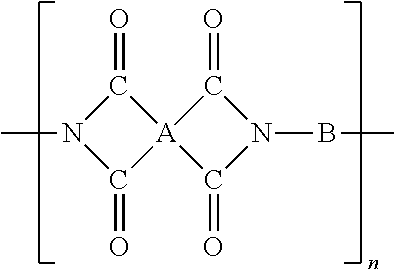Alignment material for liquid crystal display device of vertical alignment mode and method of preparing the same
a technology of vertical alignment and aligning material, which is applied in the direction of instruments, organic chemistry, transportation and packaging, etc., can solve the problems of difficult to obtain uniformly high pretilt angles in the whole region of broad substrates, difficult to achieve pretilt angles around 90 degrees, and few cases have been put to practical use, etc., to achieve good vertical alignment of liquid crystal, reduce response rate, and excellent mechanical properties
- Summary
- Abstract
- Description
- Claims
- Application Information
AI Technical Summary
Benefits of technology
Problems solved by technology
Method used
Image
Examples
example 1
[0073]The diamine compounds of formula 1 were synthesized by reaction flow 1. Synthesis in each step is as follows.
[0074](Step 1)
[0075]2.5 g (9.26 mmol) of 1-bromo-4-(3-tert-butoxy-propyl)-benzene and 3.11 g (0.0111 mol) of 1,2-difluoro-3-(4-propyl-1-cyclohexenyl)-benzene boronic acid were dissolved in 90 ml of 1,2-dimethoxyethane. 90 ml of 2M cesium fluoride aqueous solution and 0.32 g (3 mmol %) of tetrakis(triphenylphosphine)palladium were dropwise added to the reaction solution and then refluxed for 3 hours. The reaction solution was extracted with ether and sodium chloride, then dried over anhydrous magnesium sulfate and distilled under a reduced pressure and then re-crystallized with ethyl acetate and ethanol, affording a white solid (yield: 74%).
[0076]Mass: 426(M+), 370, 339, 325, 255, 229, 134, 81, 57
[0077](Step 2)
[0078]9.4 g (0.0221 mmol) of 4′-(3-tert -butoxy-propyl)-2,3-difluoro-4-(4-propyl-1-cyclohexenyl)-biphenyl was dissolved in 120 ml of acetic acid and 30 ml of bromi...
example 2
[0087]10.0 g (0.02 mmol) of 2,3-difluoro-4-(4-alkyl-cyclohexyl)-biphenyl-4′-alkyl 3,5-diamino benzoate and 8.0 g (0.04 mol) of 4,4′-diaminodiphenylether (ODA) were dissolved in 170.0 g of N-methyl-2-pyrollidone and the thus obtained reaction solution was added to 19.32 g (0.06 mol) of 3,3′,4,4′-benzophenonetetracarboxylic acid dianhydride (BTDA) and reacted for 4 hours while the temperature was being kept at 5° C. The reaction solution was precipitated in excessive amount of deionized water, providing polyamic acid. The polyamic acid solid was washed several times with deionized water using a mixer. Thereafter, it was dried in a vacuum oven of 50° C. for two days, affording polyamic acid solids, and the properties of the obtained polymers are shown in Table 1 below.
example 3
[0088]With the exception that 3,3′,4,4′-benzophenonetetracarboxylic acid dianhydride (BTDA) used in Example 2 was replaced by 4,4′-oxydiphthalic acid (ODPA), the same procedures as Example 2 were carried out, affording polyamic acid solids, and the properties of the obtained polymers are shown in Table 1 below.
PUM
| Property | Measurement | Unit |
|---|---|---|
| pretilt angles | aaaaa | aaaaa |
| pretilt angles | aaaaa | aaaaa |
| pretilt angles | aaaaa | aaaaa |
Abstract
Description
Claims
Application Information
 Login to View More
Login to View More - R&D
- Intellectual Property
- Life Sciences
- Materials
- Tech Scout
- Unparalleled Data Quality
- Higher Quality Content
- 60% Fewer Hallucinations
Browse by: Latest US Patents, China's latest patents, Technical Efficacy Thesaurus, Application Domain, Technology Topic, Popular Technical Reports.
© 2025 PatSnap. All rights reserved.Legal|Privacy policy|Modern Slavery Act Transparency Statement|Sitemap|About US| Contact US: help@patsnap.com



